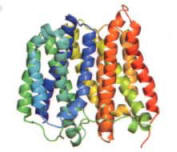
Handy Links
SLAC News Center
SLAC Today
- Subscribe
- Archives: Feb 2006-May 20, 2011
- Archives: May 23, 2011 and later
- Submit Feedback or Story Ideas
- About SLAC Today
SLAC News
Lab News
- Interactions
- Lightsources.org
- ILC NewsLine
- Int'l Science Grid This Week
- Fermilab Today
- Berkeley Lab News
- @brookhaven TODAY
- DOE Pulse
- CERN Courier
- DESY inForm
- US / LHC
SLAC Links
- Emergency
- Safety
- Policy Repository
- Site Entry Form

- Site Maps
- M & O Review
- Computing Status & Calendar
- SLAC Colloquium
- SLACspeak
- SLACspace
- SLAC Logo
- Café Menu
- Flea Market
- Web E-mail
- Marguerite Shuttle
- Discount Commuter Passes
-
Award Reporting Form
- SPIRES
- SciDoc
- Activity Groups
- Library
Stanford
Around the Bay
New Information in the Fight Against Drug-resistant Bacteria
 Scientists at The Scripps Research Institute have determined the structure of a bacterial protein that
contributes to the ability of bacteria to become resistant to life-saving antibiotics. Researchers
determined the structure with x-ray data collected at the Stanford Synchrotron Radiation Laboratory (SSRL)
and Berkeley Lab's Advanced Light Source. The study was published May 5 in ScienceXpress, an advance online
edition of the journal Science.
Scientists at The Scripps Research Institute have determined the structure of a bacterial protein that
contributes to the ability of bacteria to become resistant to life-saving antibiotics. Researchers
determined the structure with x-ray data collected at the Stanford Synchrotron Radiation Laboratory (SSRL)
and Berkeley Lab's Advanced Light Source. The study was published May 5 in ScienceXpress, an advance online
edition of the journal Science.
The continuing rise of drug-resistant disease strains is seriously undermining treatment of infectious diseases. EmrD is a transporter protein that comes from Escherichia coli (E. coli), a common bacteria known to cause sometimes fatal food-borne illnesses. EmrD expels drugs like antibiotics from bacterial cells, preventing the drugs from destroying the bacteria. The structure reveals important information that could help researchers find new ways to avoid multi-drug resistance and enhance the potency of existing drugs.
EmrD belongs to a family of transporters prevalent in the microbial world. The members of this family are distinctive in their ability to recognize and expel a diverse range of molecules which contain parts that repel water and parts that attract water (hydrophobic and hydrophilic). The x-ray structure showed the interior of EmrD has primarily hydrophobic residues that likely are part of the mechanism for transporting compounds through the cell membrane. The EmrD interior contrasts with those found in other families of drug transporters, which typically transport a narrower range of compounds.
"Determining the structure of this transporter will add significantly to our general understanding of the mechanism of drug transport through the cell membrane and provide the structural basis for how these proteins go about selecting specific drugs to expel," said Geoffrey A. Chang, Ph.D., a Scripps associate professor and a member of the Skaggs Institute for Chemical Biology.
Infections resistant to standard antibiotics are far more expensive and time-consuming to treat. According to the Centers for Disease Control (CDC), second-line drugs can cost as much as $33,000 per patient in industrialized countries compared to $84 for first-line drugs. In addition, the CDC noted, second-line drugs need to be taken for longer periods of time—from 18 to 36 months—and tend to require substantial patient monitoring, making these treatments difficult if not impossible to provide in resource-poor nations.
The study was supported by the National Institutes of Health and the Skaggs Institute for Chemical Biology. The Scripps Research Institute is headquartered in La Jolla, California.
—Heather Rock Woods SLAC Today, May 9, 2006
Text summarized from The Scripps Research Institute news release by Mika Benedyk.
Image: A side view of the bacterial protein EmrD. (Image courtesy of Geoffrey Chang, The Scripps Research Institute.)